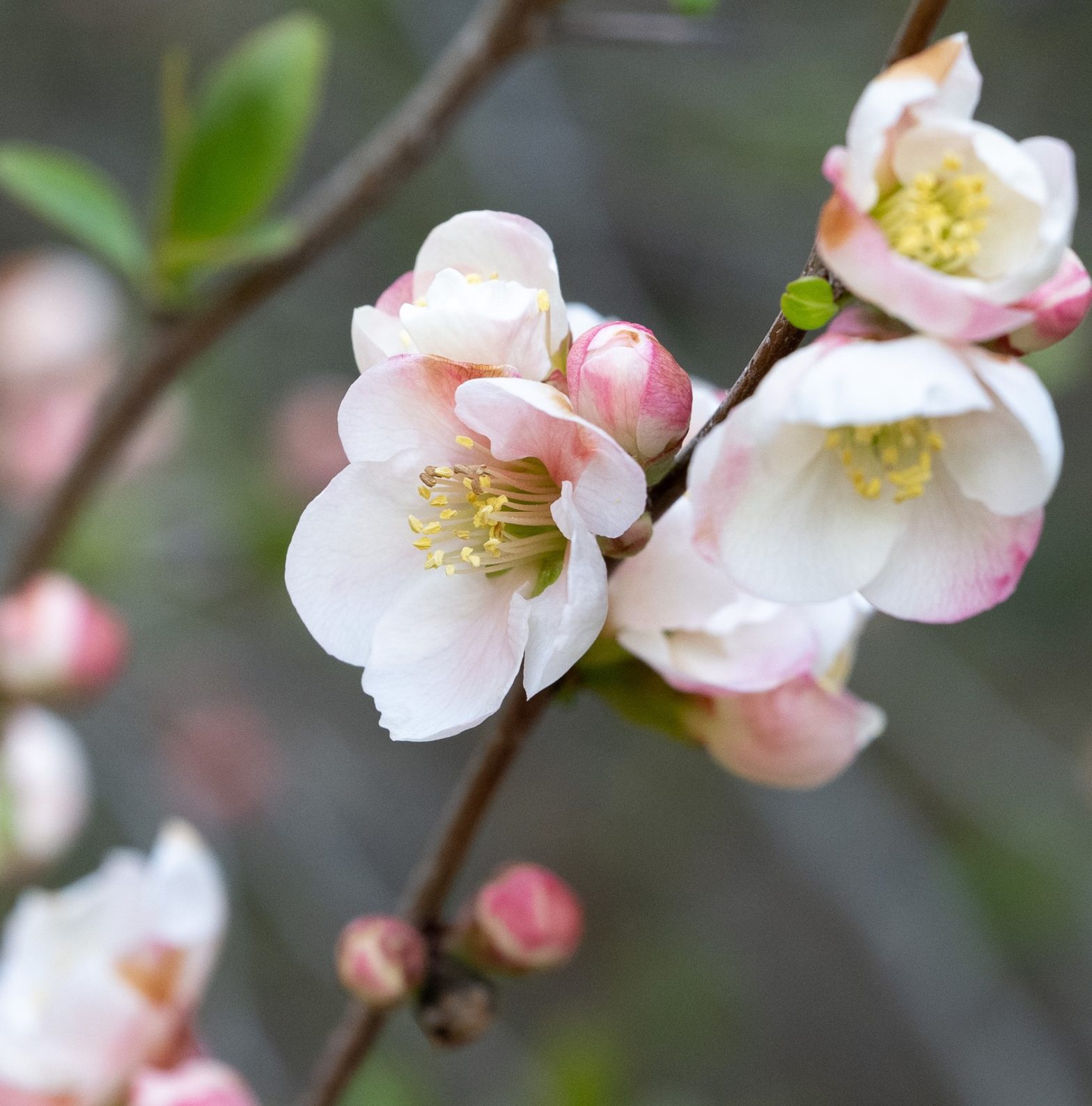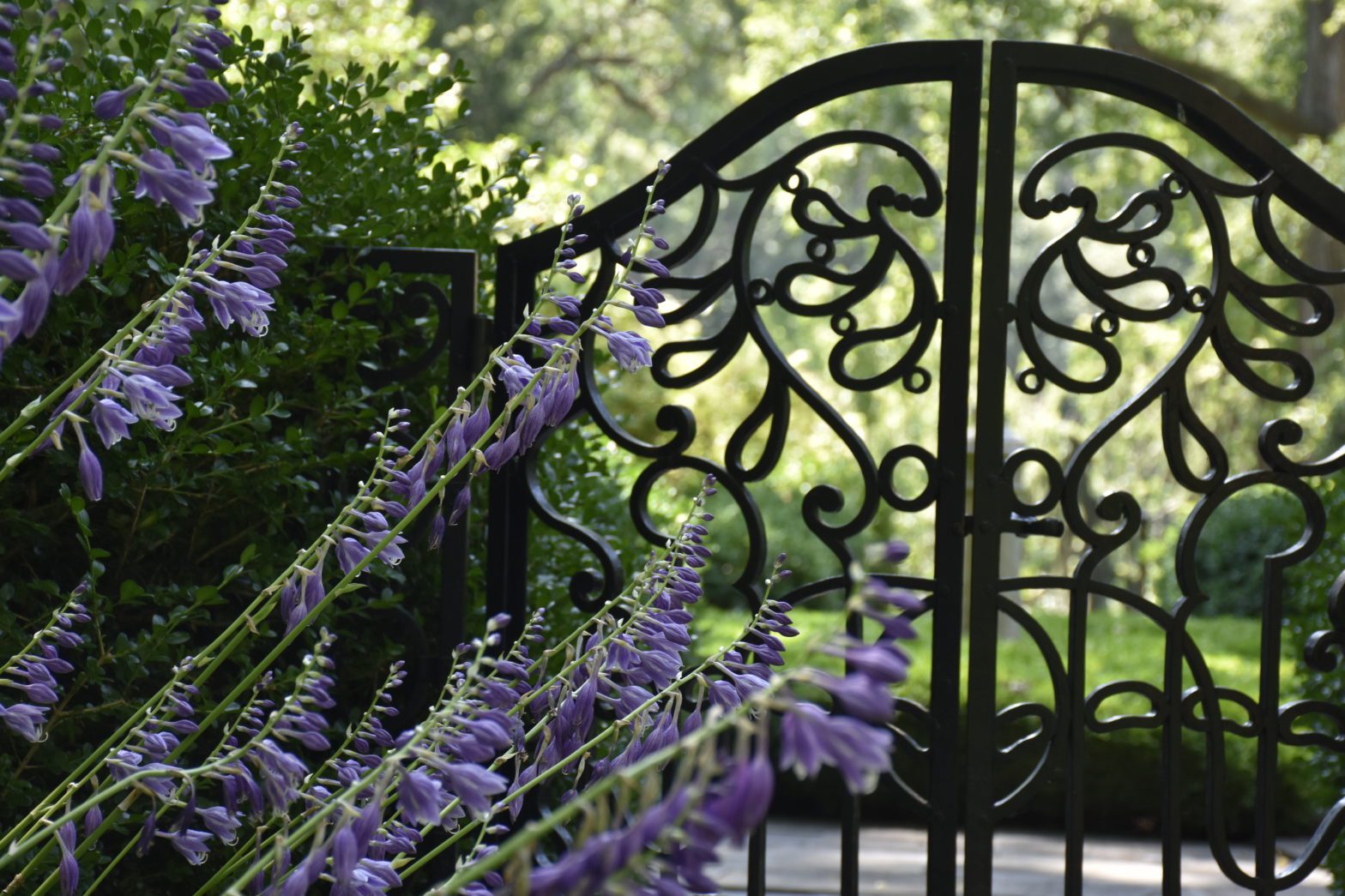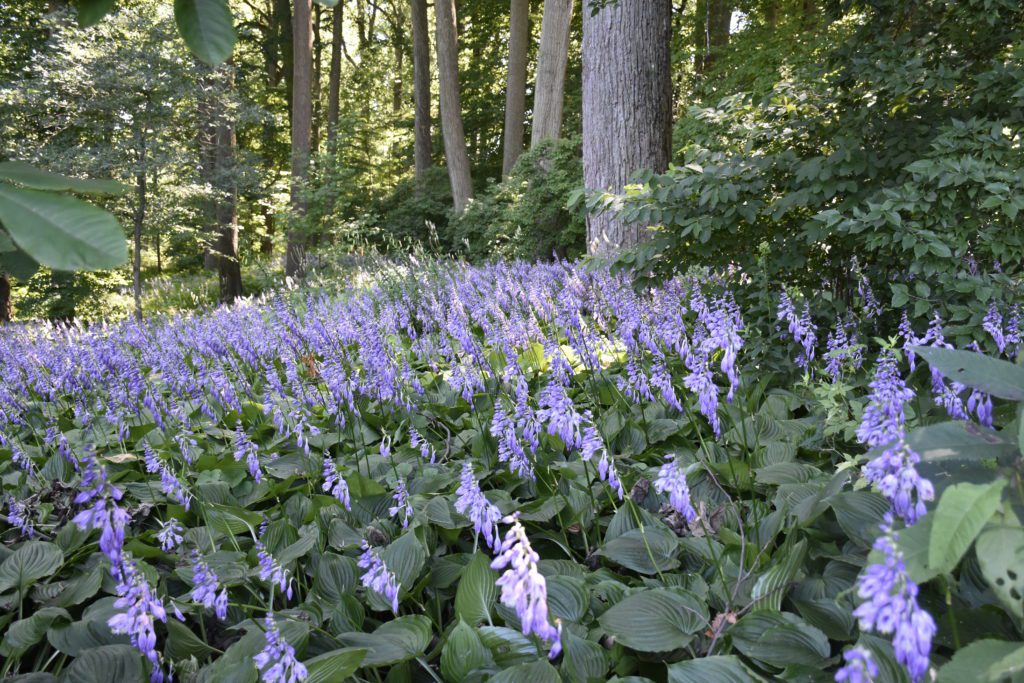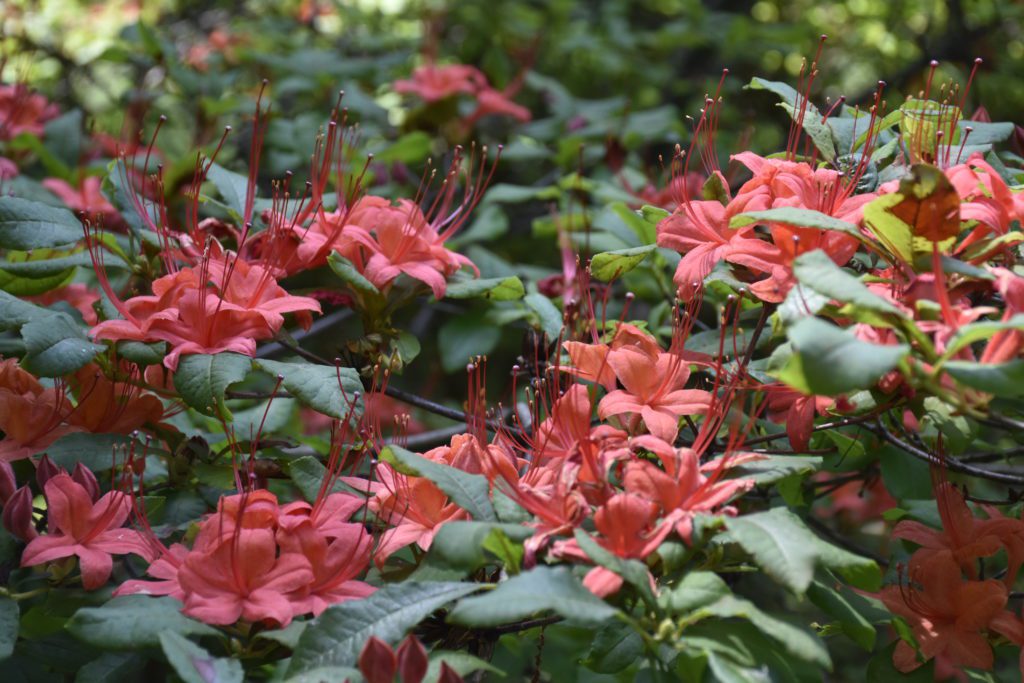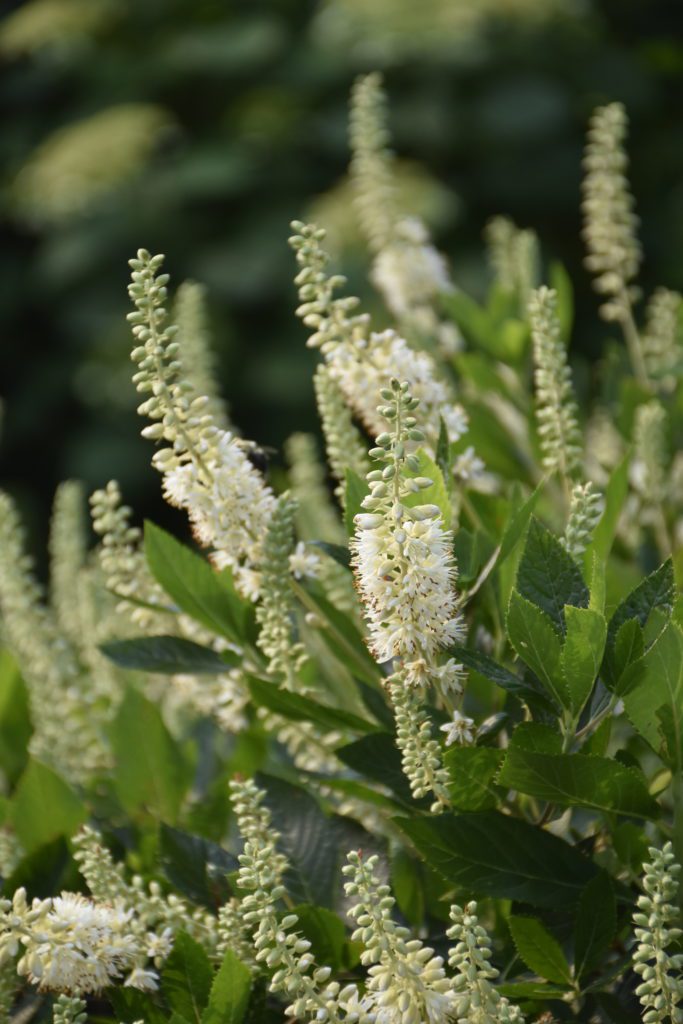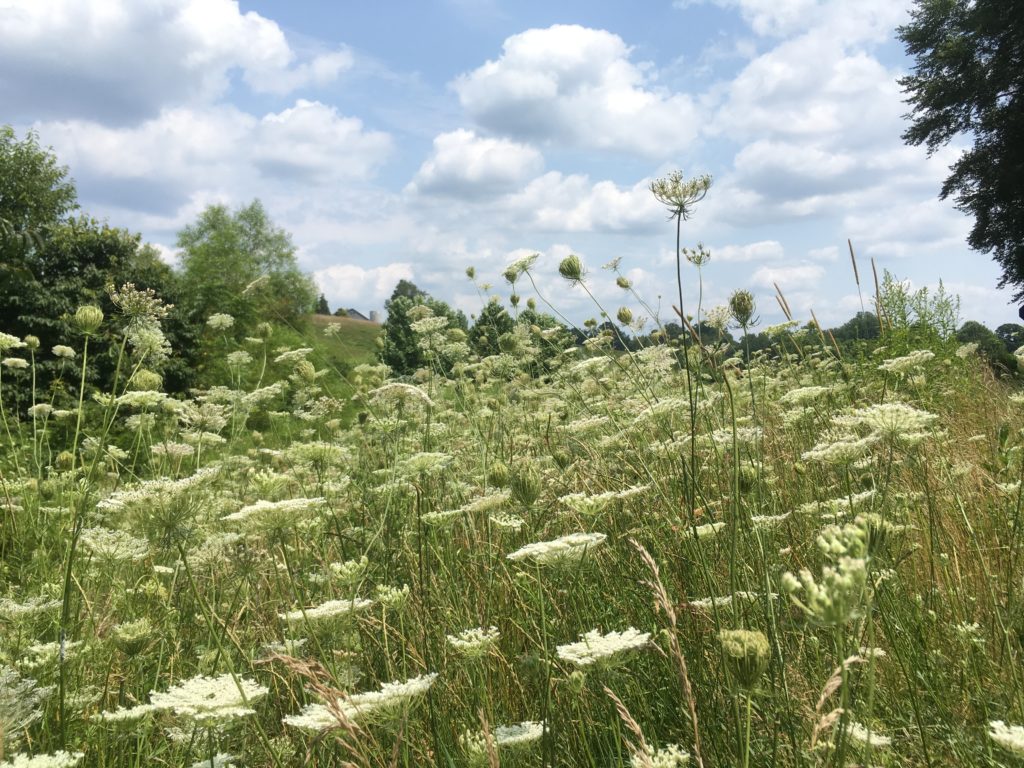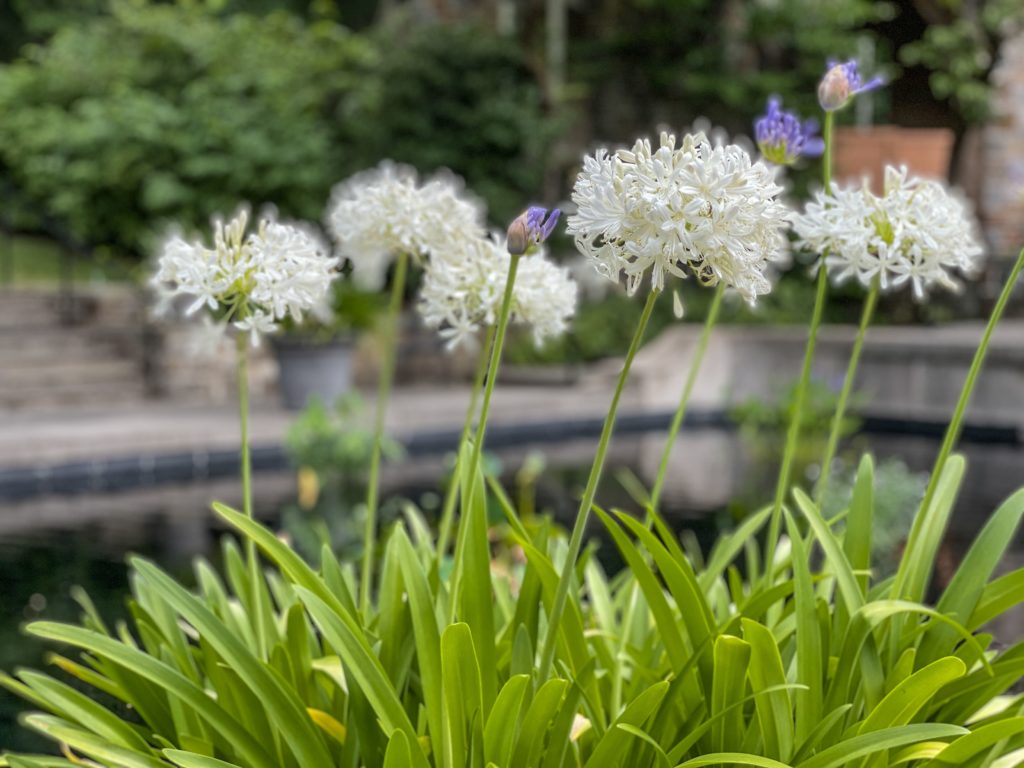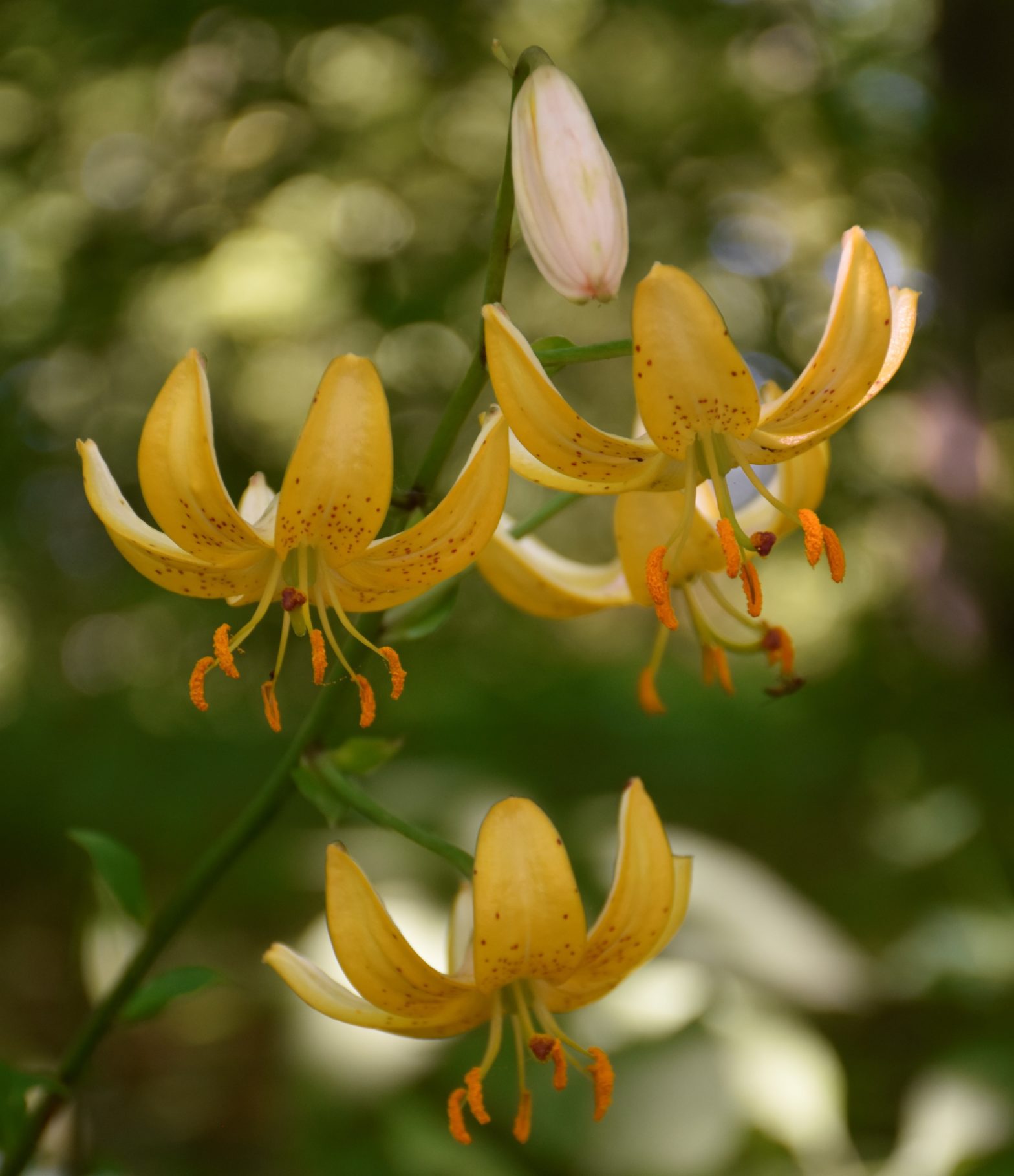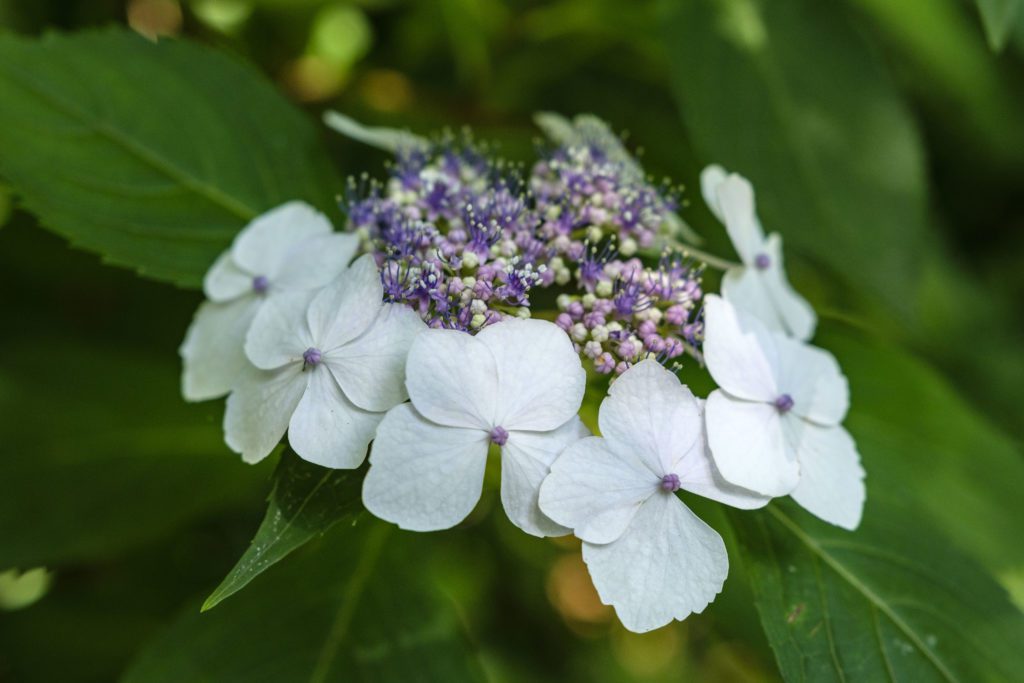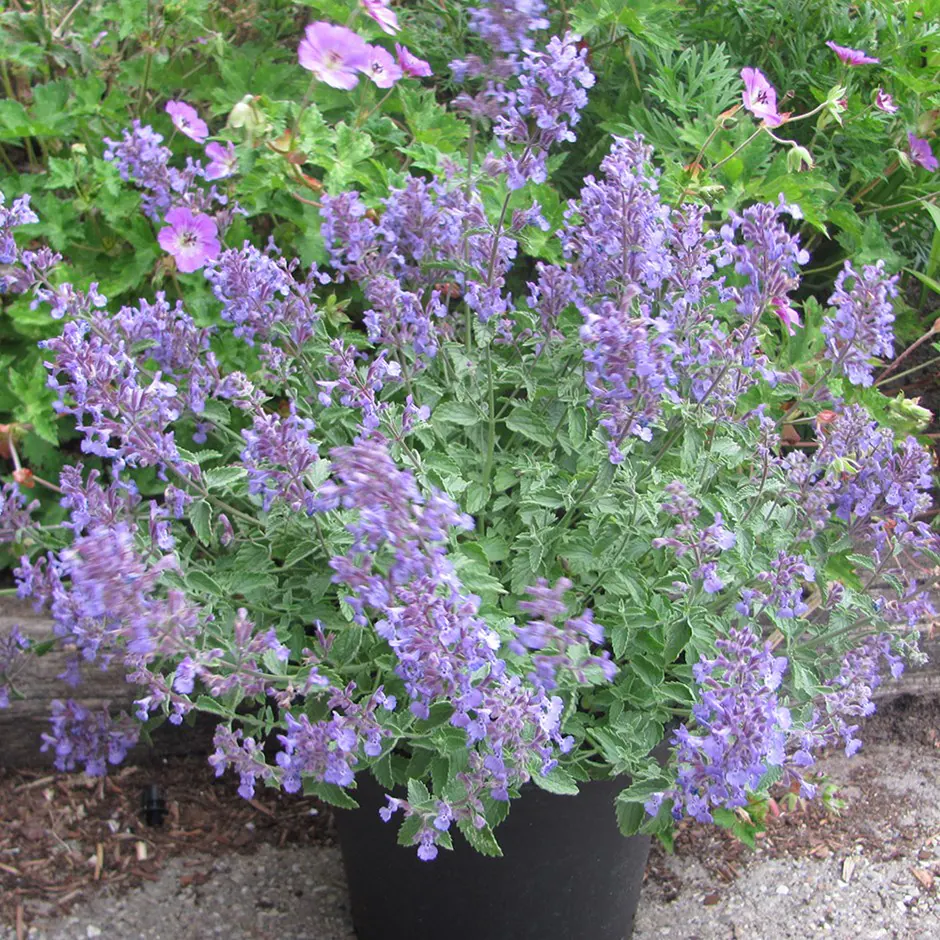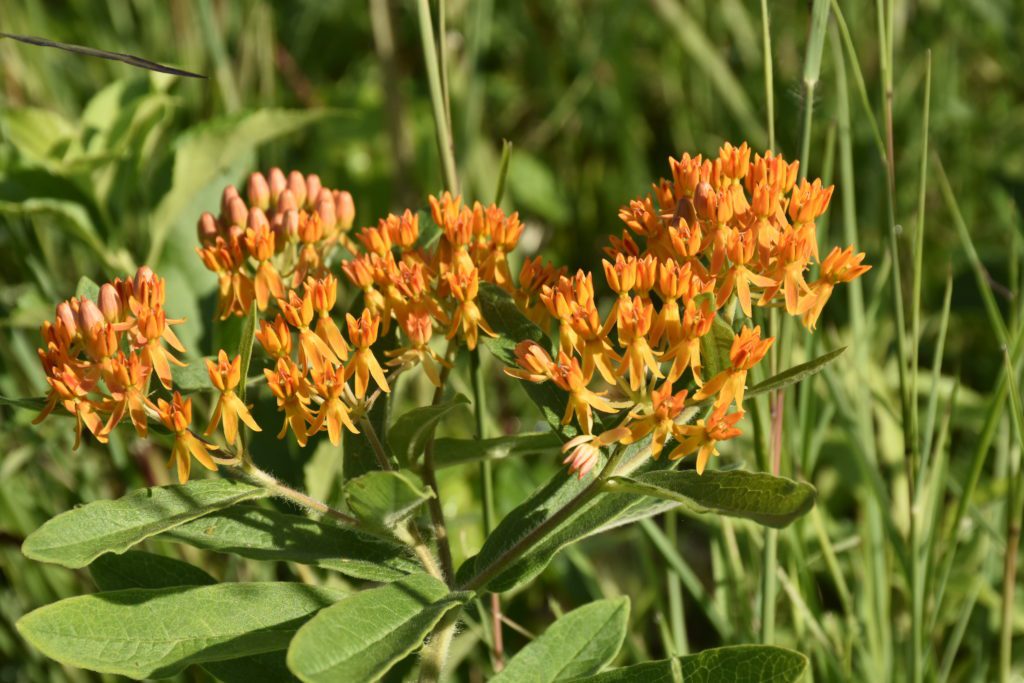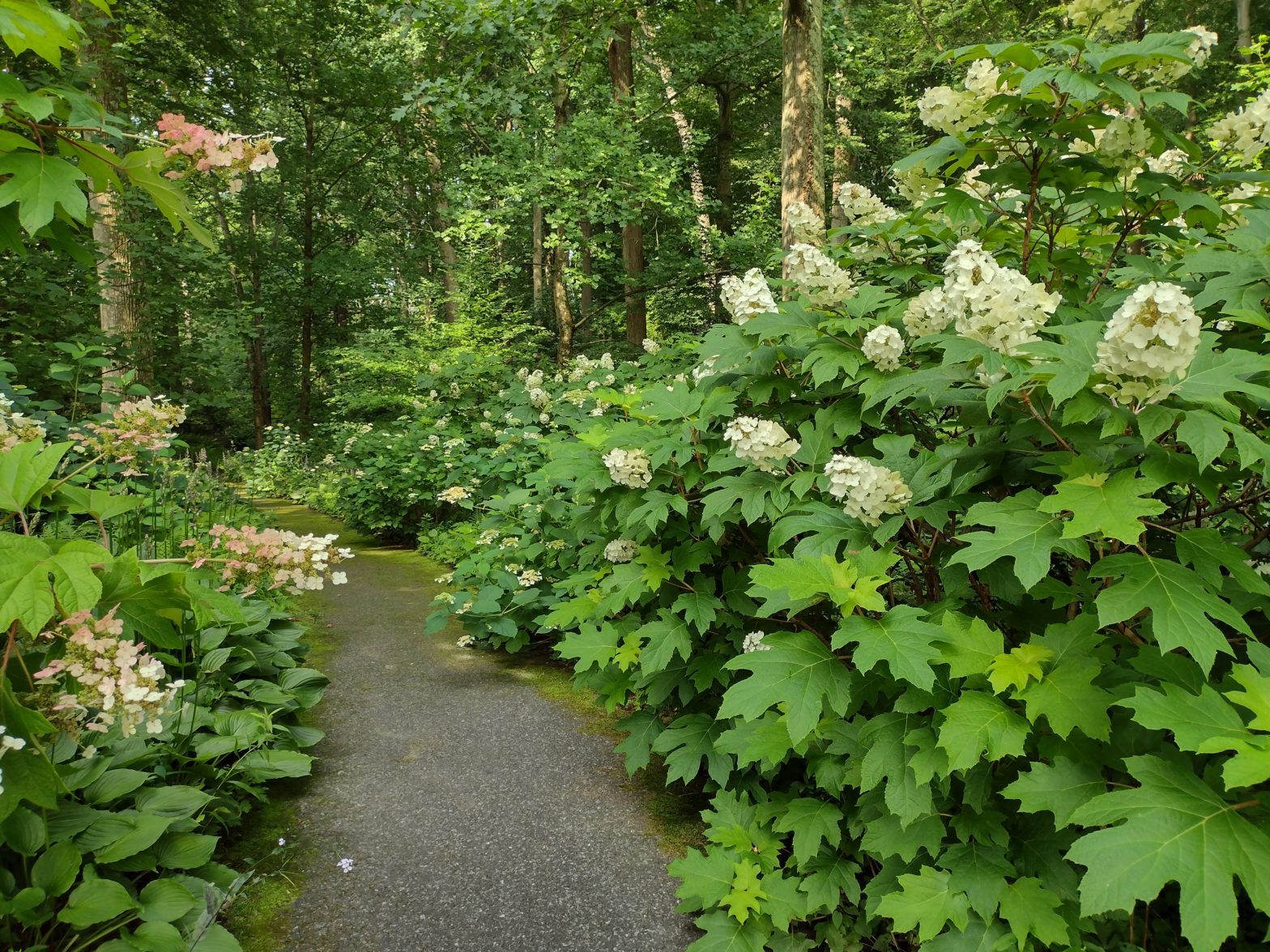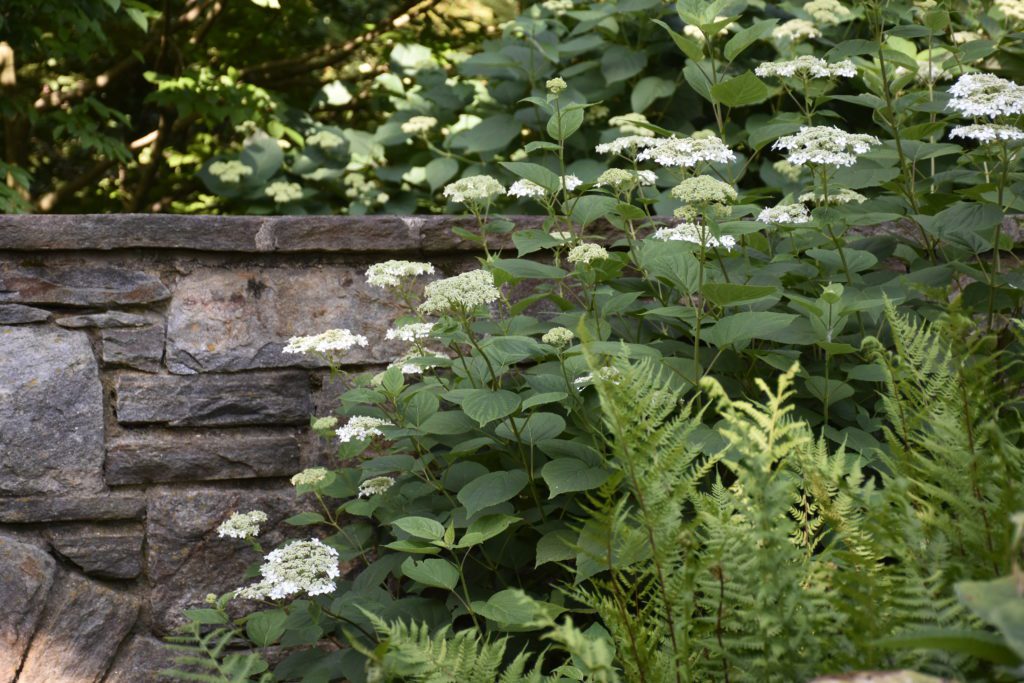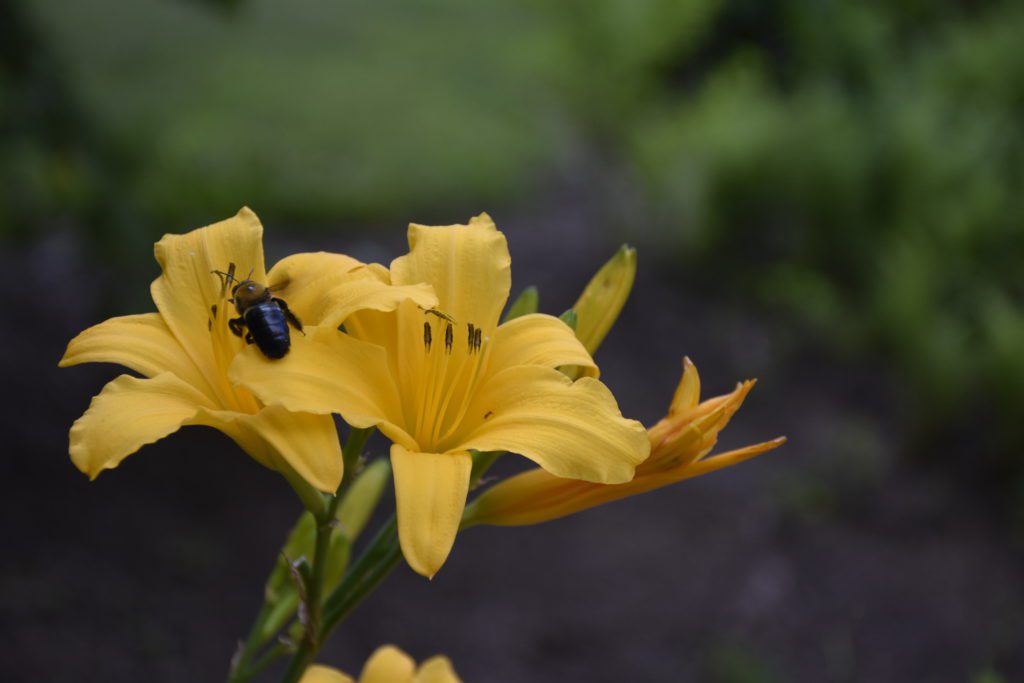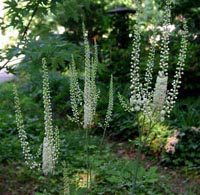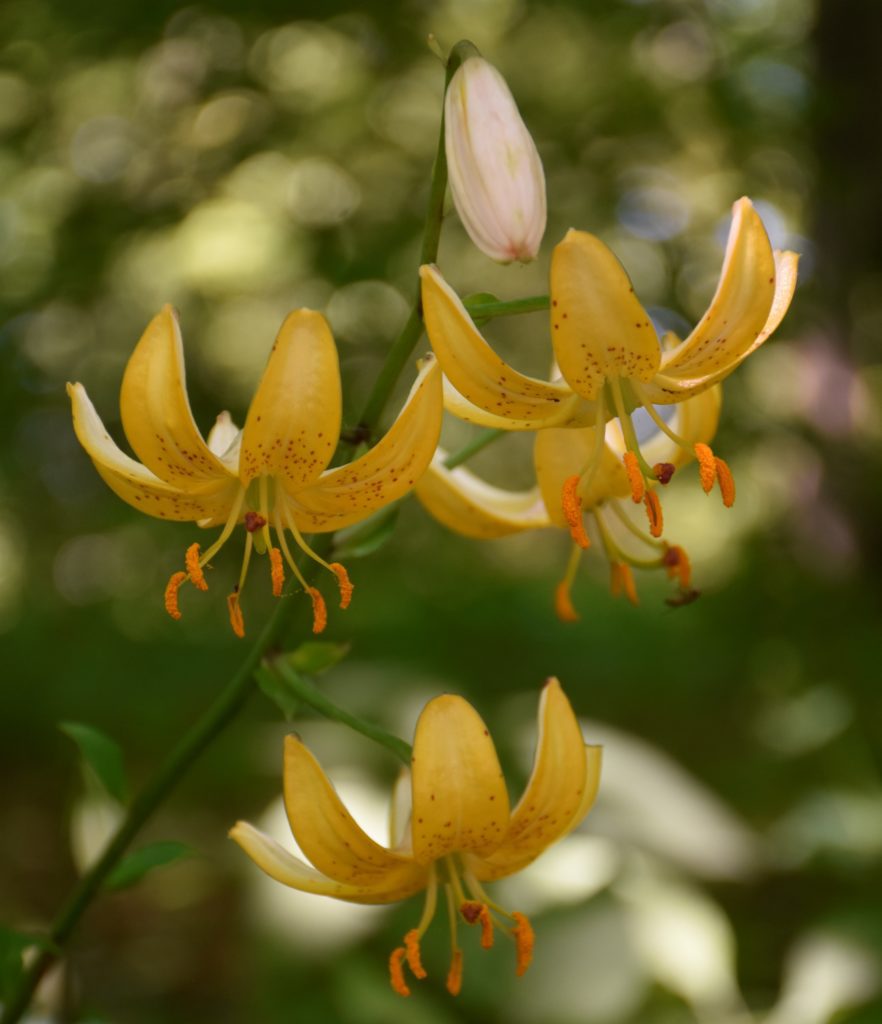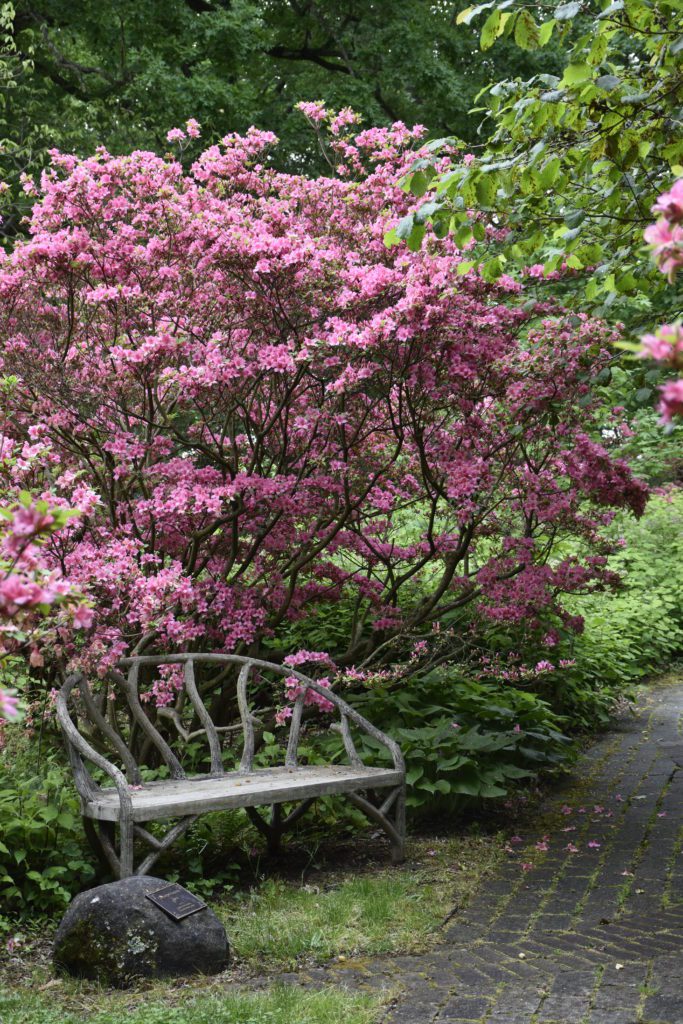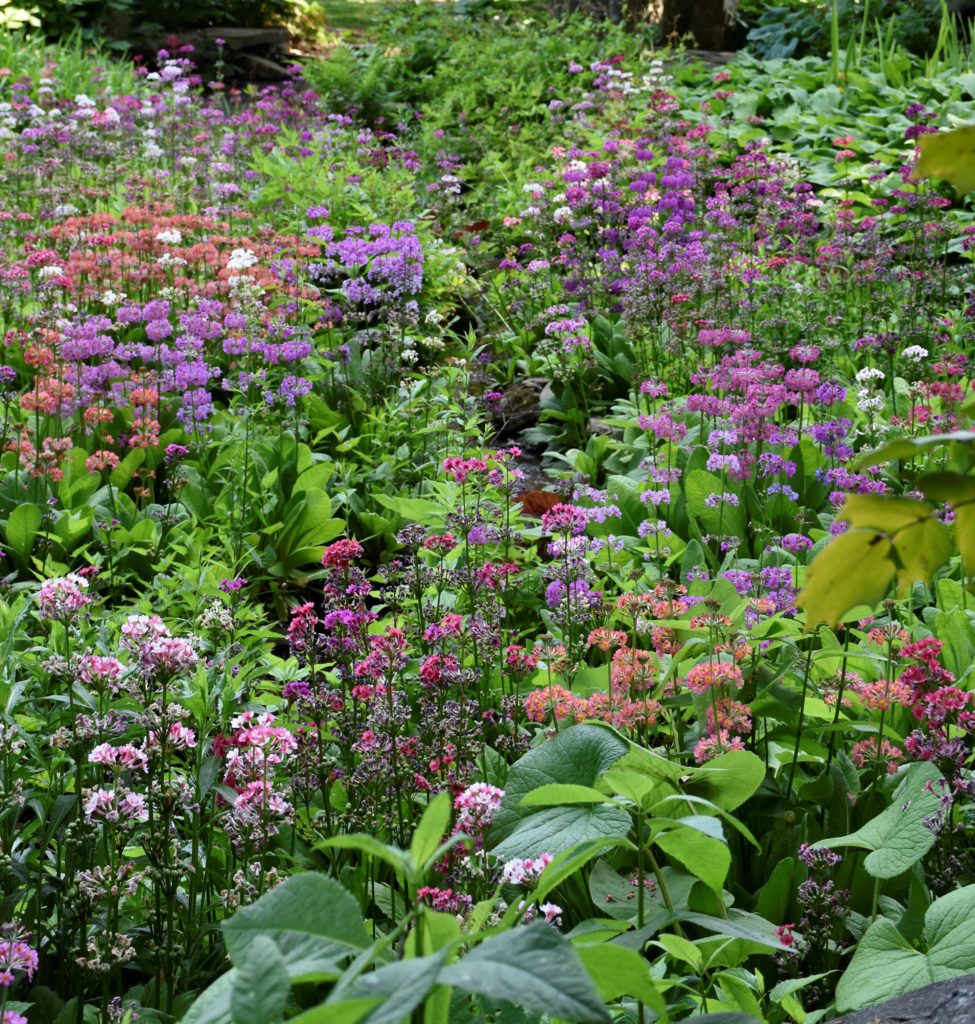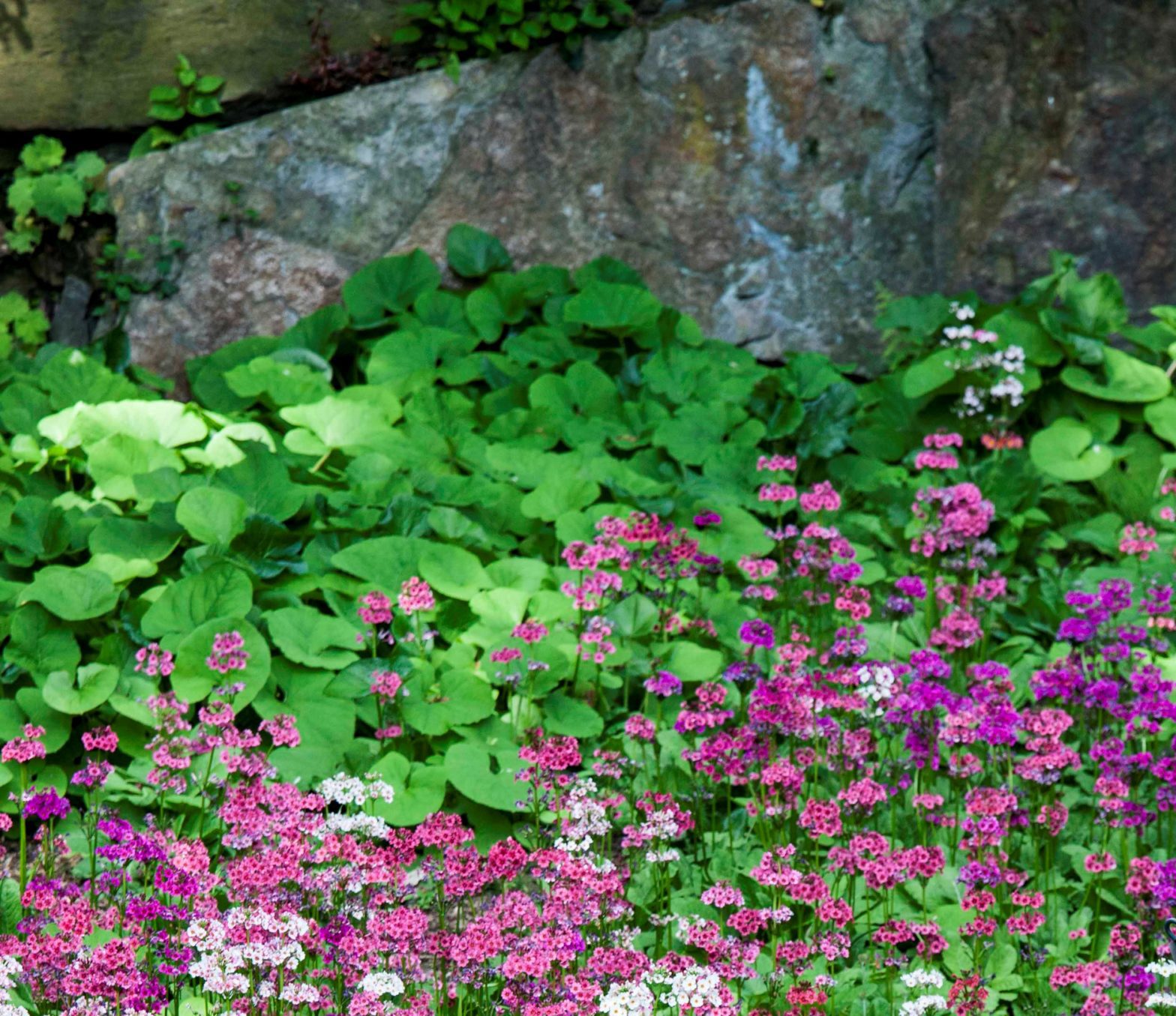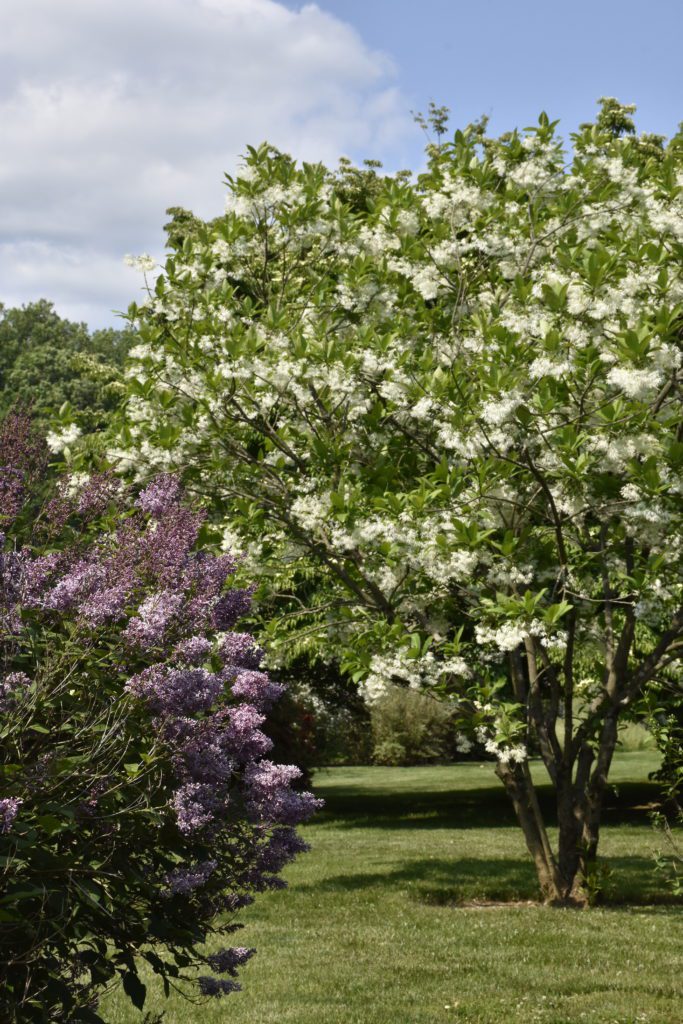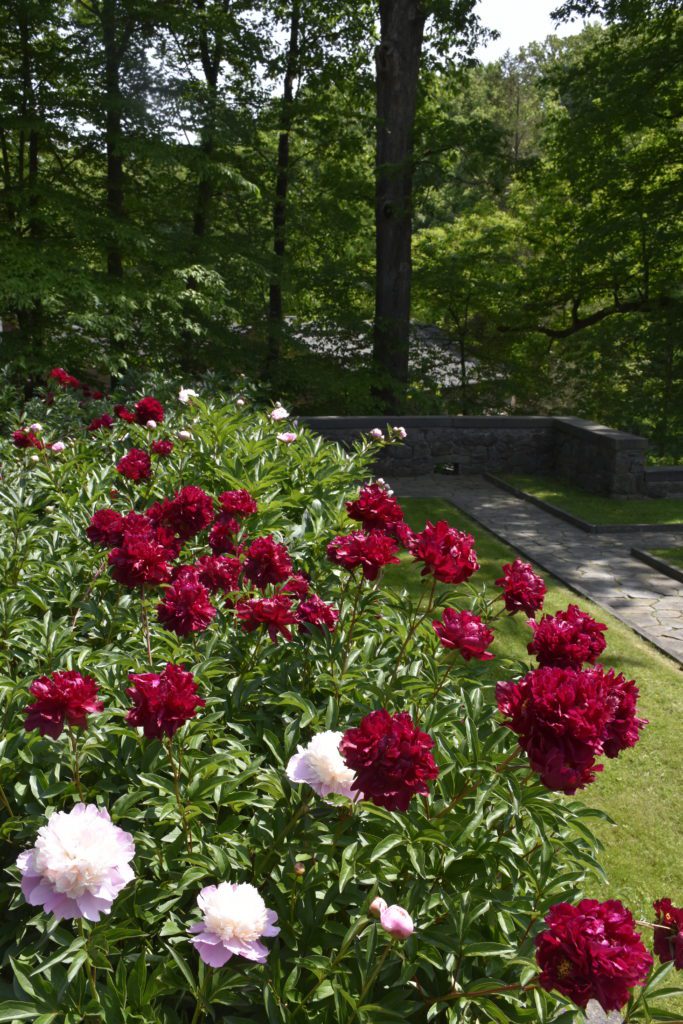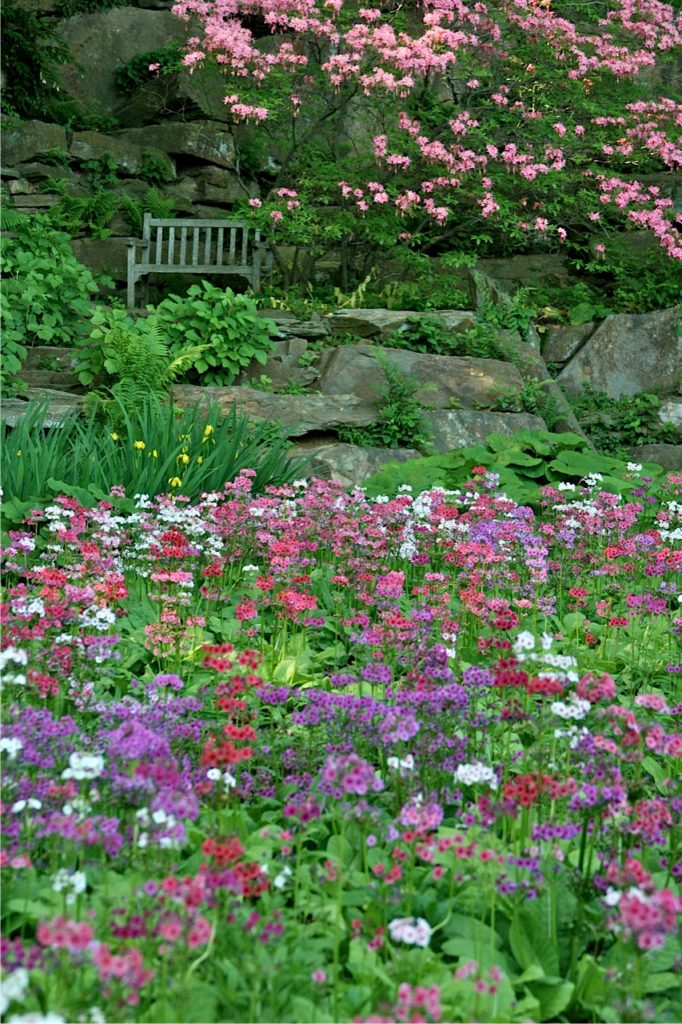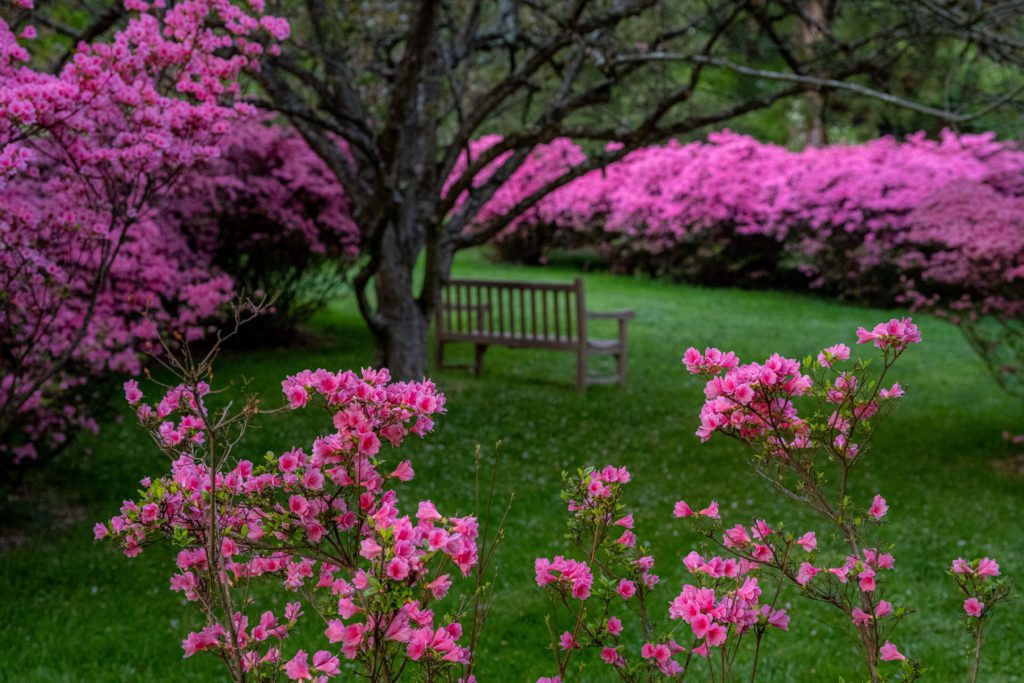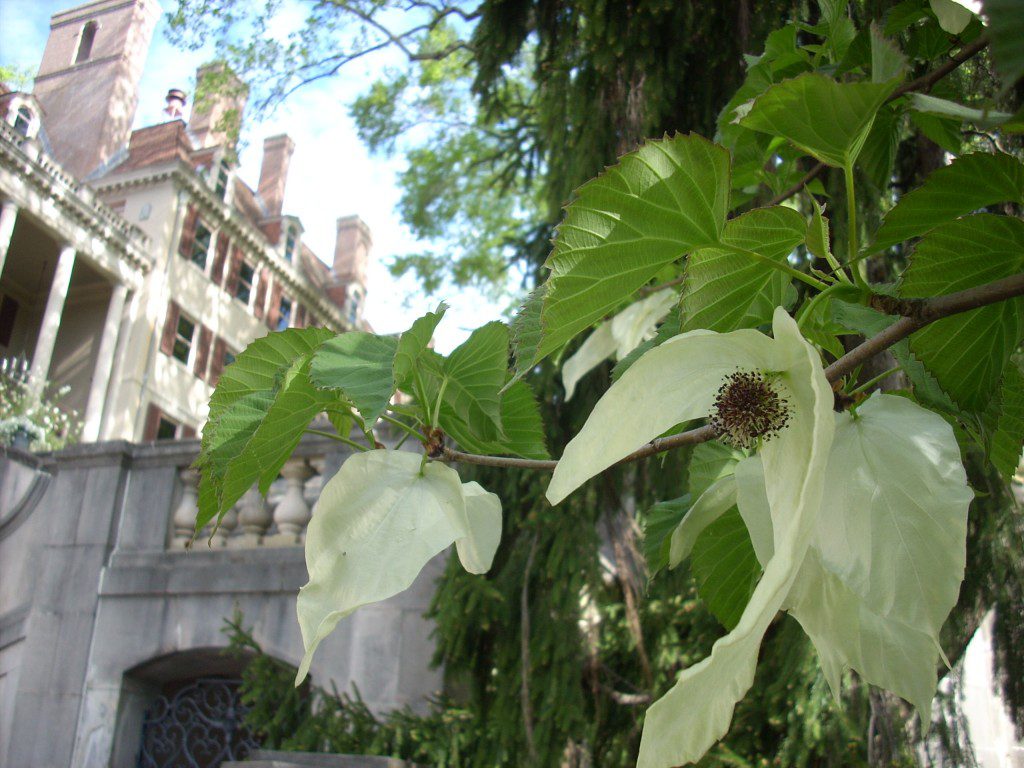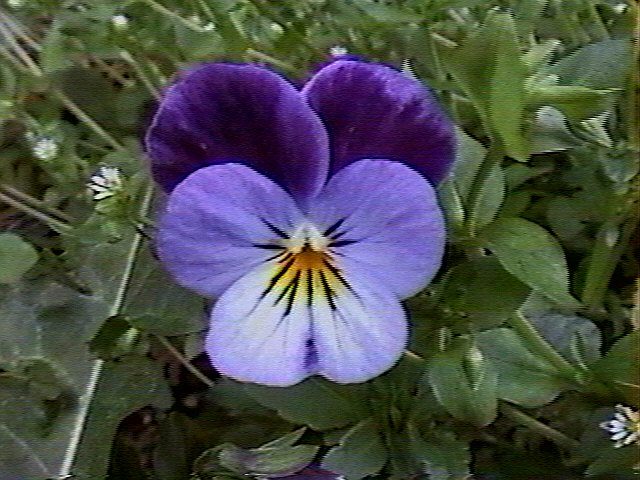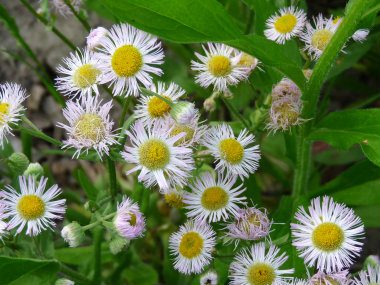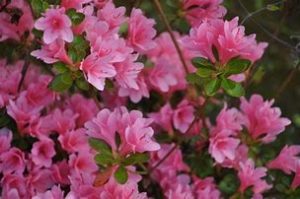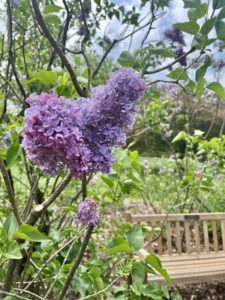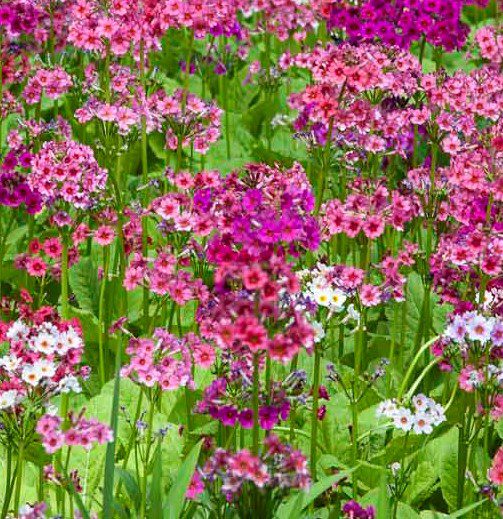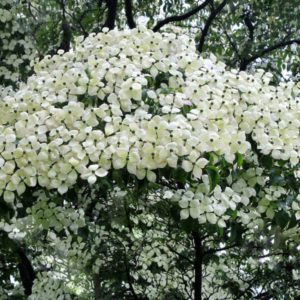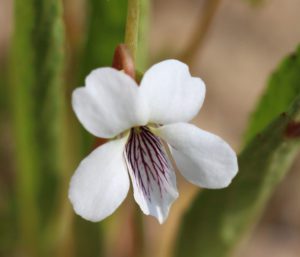Bloom Report #13
March 29, 2023
56F, Sunny
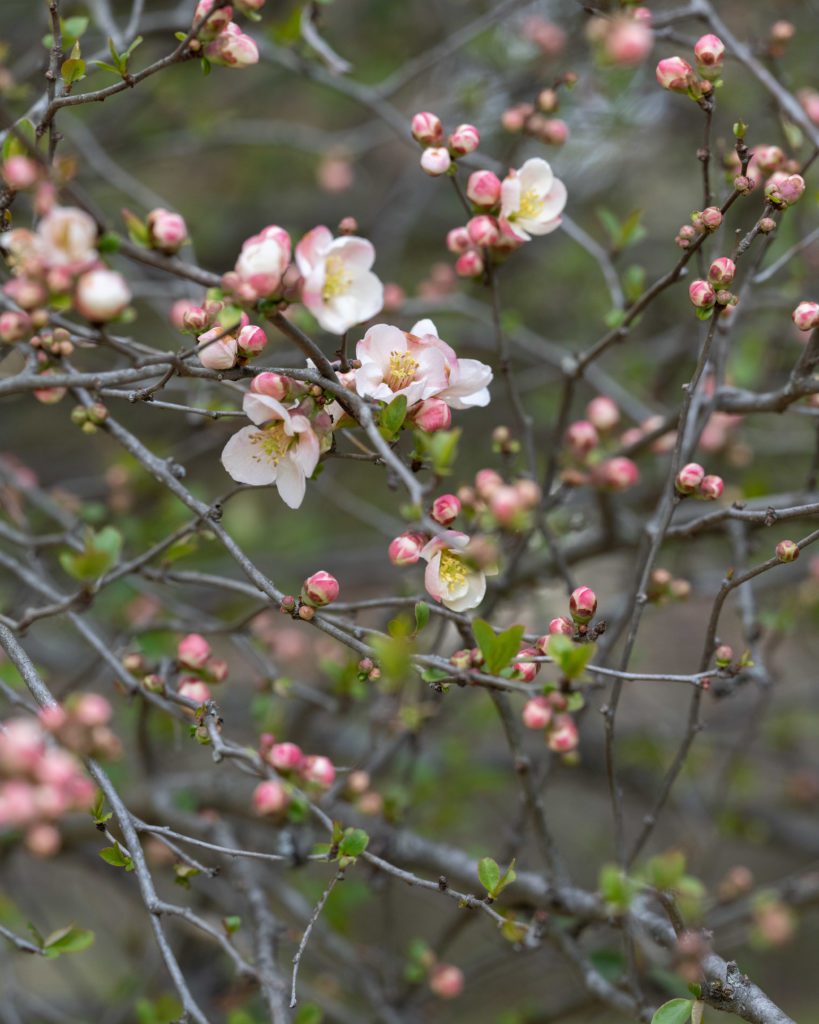
Check these out:
- Superb Sundial: Flowers of star magnolias (Magnolia stellata cultivars), saucer magnolias (Magnolia x soulangeana cultivars) and the magnificent Wada’s Memory magnolia (Magnolia ‘Wada’s Memory’) are underlined by theblooming garland spiraea (Spiraea x arguta).
- It’s a Brief Show: The white flowers of bloodroot (Sanguinaria canadensis) are blooming in many areas of the garden this week. They are particularly abundant on the hill below the walkway at the lower edge of the Parking Area and in the Quarry Garden on the upper hillside facing Sycamore Hill. Their flowers last a very short time.
- A River of Blue: It starts in Azalea Woods, flows down the lawn to the Museum including the upper East Terrace, down the March Bank and up the opposite side to the walkway from Winterhazel Walk to Icewell Terrace. It’s made up of lavender blue glory-of-the-snow (Chionodoxa forbesii), royal blue Siberian squill (Scilla siberica), and blue to white Italian anemone (Anemone apennina). The sunken garden in the Greenhouse area is a sea of intense blue and the rest of the gardens have blue accents in greater or lesser numbers.
- Flowering Quince: The Quince Walk area of the Pinetum is filled with the bright red, red-orange, peach, and white blossoms of flowering quince (Chaenomeles species & cultivars).
- Heavenly Hellebores: The Lenten roses (Helleborus species & hybrids) are blooming in white, pink spotted, pink, & wine red in the Greenhouse sunken garden, in front of The Cottage, along Winterhazel Walk, at the edge of the Pinetum and in the raised bed in the Museum East courtyard.
ENTRANCE DRIVE AND PARKING AREA
fb Cornus officinalis (Japanese cornel dogwood – yellow)
fb Corylopsis species (Winterhazel – pale yellow)
fb Forsythia x intermedia (Border forsythia – yellow)
fb Lindera benzoin (Spicebush – yellow)
b Narcissus species (Daffodil – yellow, white)
fb Prunus species (Cherry – pale pink, white – along Clenny Run)
fbb Prunus yedoensis ‘Shidare-Yoshino’ (Yoshino weeping cherry – white to pale pink)
fb,+ Sanguinaria canadensis (Bloodroot – white – below walkway from Picnic House on lower side of Parking Area)
LAGOONS AND CLENNY RUN
fb Claytonia virginica (Spring beauty – white to pale pink – on far side of Clenny Run)
fb Narcissus species (Daffodil – yellow – on far side of Clenny Run)
fb Prunus species (Cherry – pink, white – on far side of Clenny Run)
fb,++ Scilla siberica ‘Spring Beauty’ (Siberian squill – royal blue – on far side of Clenny Run)
SUMMER SHRUB SLOPE
pf Narcissus species (Daffodil – yellow)
PARKING AREA TO VISITOR CENTER
pf Chionodoxa forbesii (Glory-of-the-snow – lavender blue)
fb Claytonia virginica (Spring beauty – white to pale pink)
fb Cornus officinalis ‘Kintoki’ (Japanese cornel dogwood – yellow)
pb Galanthus elwesii (Giant snowdrop – white)
pb Galanthus nivalis (Common snowdrop – white)
pf Galanthus nivalis ‘Flore Pleno’ (Double snowdrop variety – white & green)
pb Leucojum vernum (Spring snowflake – white ‘bells’)
fbb Mertensia virginica (Virginia bluebells – purple to pink buds, blue flowers)
fb Narcissus species (Daffodil – yellow, white)
fb Pachysandra terminalis (Pachysandra – ivory)
fb Pieris japonica (Andromeda – white)
fb Pieris japonica ‘Flamingo’ (Andromeda cultivar – pale pink)
fb Sanguinaria canadensis (Bloodroot – white)
WALK FROM VISITOR CENTER TO UNDERPASS
fb Anemone apennina (Italian windflower – blue, pink, white)
fb Chionodoxa forbesii (Glory-of-the-snow – lavender blue)
fb Corylopsis ‘Winterthur’ (Winterhazel cultivar – pale yellow)
pf Galanthus nivalis ‘Flore Pleno’ (Double snowdrop variety – white & green)
fb Lindera benzoin (Spicebush – yellow)
fb Magnolia stellata (Star magnolia – white)
fbb Mertensia virginica (Virginia bluebells – purple to pink buds, blue flowers)
fb Narcissus species (Daffodil – yellow, white)
fb Pachysandra terminalis (Pachysandra – ivory)
b Petasites japonicus (Giant butterbur – ivory-white ‘bottlebrush’)
fb Puschkinia scilloides (Striped squill – white with minute blue stripes)
fb Ranunculus ficaria/Ficaria verna (Lesser celandine – yellow)
fb Scilla siberica ‘Spring Beauty’ (Siberian squill – royal blue)
WALK FROM UNDERPASS TO MUSHROOM
fb Chionodoxa forbesii (Glory-of-the-snow – lavender blue)
fb Claytonia virginica (Spring beauty – white to pale pink)
b Dentaria laciniata (Cut-leaf toothwort – white)
pb Leucojum vernum (Spring snowflake – white ‘bells’)
b Mertensia virginica (Virginia blue bells – blue – few flowers)
fb Narcissus species (Daffodil – yellow)
fb Prunus species (Flowering cherry – pale pink to white)
fb Puschkinia scilloides (Striped squill – white with minute blue stripes)
fb Scilla siberica ‘Spring Beauty’ (Siberian squill – royal blue)
SLOPE DOWN TOWARDS MUSEUM
fb Chionodoxa forbesii (Glory-of-the-snow – lavender blue)
fb Claytonia virginica (Spring beauty – white to pale pink)
pb Crocus hybrids (Dutch crocus – purple, white)
fb Magnolia denudata (Yulan magnolia – white)
fb Narcissus species (Daffodil – yellow)
fb Scilla siberica ‘Spring Beauty’ (Siberian squill – royal blue)
PEONY GARDEN
fb Chionodoxa forbesii (Glory-of-the-snow – lavender blue)
fb Forsythia suspensa (Weeping forsythia – yellow)
fb Forsythia viridissima (Greenstem forsythia – yellow)
fb Forsythia x intermedia (Border forsythia – yellow)
fb Lonicera fragrantissima (Fragrant honeysuckle – white)
fb Narcissus species (Daffodil – yellow & cream)
AZALEA WOODS
fb,++ Anemone apennina (Italian windflower – blue, white)
fb,+ Chionodoxa forbesii (Glory-of-the-snow – lavender blue)
fb Forsythia x intermedia (Border forsythia – yellow – at field edge of woods)
fb Helleborus x hybridus (Lenten rose – pink, dark pink, white)
fb Hepatica acutiloba (Hepatica – white)
b Mertensia virginica (Virginia bluebells – purple to pink buds, blue flowers)
fb Narcissus species (Daffodil – yellow)
fbb Polemonium reptans (Jacob’s ladder – blue – few flowers)
fb Primula elatior (Oxlip primrose – pale yellow)
b Rhododendron fargesii (Rhododendron – light pink)
fb Sanguinaria canadensis (Bloodroot – white)
fb Scilla siberica ‘Spring Beauty’ (Siberian squill – royal blue)
fb Vinca minor (Periwinkle – blue, white)
LOWER AZALEA WOODS
fb Anemone apennina (Italian windflower – blue, white)
fb Chionodoxa forbesii (Glory-of-the-snow – lavender blue)
b Mertensia virginica (Virginia bluebells – purple to pink buds, blue flowers)
fb Pachysandra terminalis (Pachysandra – ivory)
b Rhododendron fargesii (Rhododendron – light pink)
b Rhododendron oreodoxa var. fargesii (Pere Farge’s rhododendron – pink)
fb Scilla siberica ‘Spring Beauty’ (Siberian squill – royal blue)
fb Viola species (Violet – blue, white striped with blue)
UPPER/EAST TERRACE AND STEPS
fb Adonis amurensis (Amur adonis – golden yellow)
fb Camellia japonica ‘April Remembered’ (Camellia cultivar ‘April Remembered‘– white to pale pink)
fb Chionodoxa forbesii (Glory-of-the-snow – lavender blue)
fb Claytonia virginica (Spring beauty – white to pale pink)
fb Cornus officinalis (Japanese cornel dogwood – yellow – at Terrace wall)
fb Corylopsis pauciflora (Buttercup winterhazel – pale yellow)
pf Galanthus ‘E.A. Bowles’ (Snowdrop cultivar – white)
pf Galanthus ‘Primrose Warburg’ (Snowdrop cultivar – white)
fb Galanthus ‘Starling’ (Snowdrop cultivar – double white)
pf Galanthus x valentinei (Snowdrop hybrid – white)
pb Jasminum nudiflorum (Winter jasmine – yellow – few flowers)
fb Lonicera fragrantissima (Fragrant honeysuckle – white)
fbb Mertensia virginica (Virginia bluebells – purple to pink buds, blue flowers)
pf Narcissus species (Dwarf daffodil – yellow – at Terrace wall)
fb Pieris japonica (Andromeda – white)
fb Pieris japonica ‘Dorothy Wycoff’ (Andromeda cultivar – pale pink to white)
fb Scilla siberica ‘Spring Beauty’ (Siberian squill – royal blue)
fb Vinca minor (Periwinkle – blue)
EAST FRONT OF MUSEUM & Around Corner
fb Chionodoxa forbesii (Glory-of-the-snow – lavender blue – behind Bath House)
fb,+ Helleborus ‘Brandywine’ (Lenten rose cultivars – pink, white, wine red)
fb Lonicera fragrantissima (Fragrant honeysuckle – white – along Garden Lane across from Bath House)
WALK FROM GLASS CORRIDOR TO REFLECTING POOL
pf Adonis amurensis (Amur adonis – golden yellow)
fb Chionodoxa forbesii (Glory-of-the-snow – lavender blue)
fb Corydalis cheilanthifolia (Fern leaf corydalis – yellow)
fb Helleborus x hybridus (Lenten rose – dark pink)
pf Galanthus nivalis ‘Flore Pleno’ (Double snowdrop variety – white & green)
fbb Mertensia virginica (Virginia bluebells – purple to pink buds, blue flowers)
fb,+ Narcissus species (Daffodil – yellow)
fb Narcissus species (Dwarf daffodil – yellow)
fb Vinca minor (Periwinkle – white, blue, purple)
WALK FROM FISH PONDS – THE GLADE – TO BRIDGE
fb Anemone apennina (Italina windflower – blue, white, pink)
fb Chionodoxa forbesii (Glory-of-the-snow – blue)
fb Corydalis cheilanthifolia (Fern leaf corydalis – yellow)
b Dentaria laciniata (Cut-leaf toothwort – white)
fb Epimedium x versicolor ‘Sulphureum’ (Fairy wings – soft yellow)
fb Galanthus nivalis ‘Flore Pleno’ (Double snowdrop cultivar – white & green)
fb Lonicera fragrantissima (Fragrant honeysuckle – white)
pb Mahonia bealei (Leatherleaf mahonia – greenish-yellow)
b Mertensia virginica (Virgnina bluebells – purple to pink buds, blue flowers)
fb Narcissus species (Daffodil – yellow)
fb Pachysandra terminalis (Pachysandra – ivory)
fb Scilla siberica ’Spring Beauty’ (Siberian squill – royal blue)
fb Vinca minor (Periwinkle – white)
MARCH BANK
pb Adonis amurensis (Amur adonis – golden yellow)
fb Anemone apennina (Italian windflower – blue, white, pink)
b Anemone ranunculoides (Buttercup windflower – yellow)
fb,+ Chionodoxa forbesii (Glory-of-the-snow – blue)
fb Claytonia virginica (Spring beauty – white to pale pink)
fb Cornus officinalis (Japanese cornel dogwood – yellow)
pb Crocus hybrids (Dutch crocus – purple, lavender, white)
pf Galanthus nivalis ‘Flore Pleno’ (Double snowdrop variety – white & green)
fb Magnolia stellata ‘Waterlily’ (Star magnolia cultivar – white – along stream)
fbb Mertensia virginica (Virginia bluebells – purple to pink buds, blue flowers)
fb Narcissus species (Daffodil – yellow)
fb Narcissus species (Dwarf daffodil – yellow)
fb Pachysandra terminalis (Pachysandra – ivory)
fb Sanguinaria canadensis (Bloodroot – white)
fb Scilla siberica ‘Spring Beauty’ (Siberian squill – royal blue)
MAGNOLIA BEND AND WALK ON SOUTH SIDE OF STREAM
fb,+ Chionodoxa forbesii (Glory-of-the-snow – lavender blue)
fb Claytonia virginica (Spring beauty – white to pale pink)
fbb Dentaria laciniata (Cut-leaf toothwort – white)
fb Lindera benzoin (Spicebush – yellow)
fbb Magnolia species & cultivars (Saucer magnolia – pink, dark pink)
fbb Mertensia virginica (Virginia bluebells – purple to pink buds, blue flowers)
fb Narcissus species (Daffodil – yellow)
fb Narcissus species (Dwarf daffodil – yellow)
fb Pachysandra terminalis (Pachysandra – ivory)
fbb Prinsepia sinensis (Cherry prinsepia – yellow)
fb Sanguinaria canadensis (Bloodroot – white)
fb Scilla siberica (Siberian squill – royal blue)
b Narcissus species (Daffodil – yellow, white)
fb Prunus ‘Accolade’ (Flowering cherry hybrid – light pink)
fbb Prunus ‘Sargentii’ (Sargent cherry – white)
b Prunus subhirtella (Winter flowering cherry – pale pink to white)
b Prunus subhirtella var. autumnalis (Autumn rosebud cherry – pale pink to white)
fb Prunus tomentosa (Manchu cherry – white, pink)
fbb Rhododendron ‘Keiskrak’ (Azalea cultivar – white)
fb Rhododendron mucronulatum ‘Cornell Pink’ (Korean rhododendron cultivar – pink)
fb Viburnum farreri (Fragrant viburnum – pale pink to white)
WINTERHAZEL WALK
fb,++ Chionodoxa forbesii (Glory-of-the-snow – lavender blue)
b Corydalis solida subsp. densiflora (Bulb corydalis – mauve)
fb Corylopsis species (Winterhazel – pale yellow)
pb Crocus hybrids (Dutch crocus – purple)
fb Helleborus species & hybrids (Lenten rose – pink, white)
fb Hepatica acutiloba (Hepatica – white)
fb Primula abchasica (Abchasica primrose – cerise with yellow center)
fb Prinsepia sinensis (Cherry prinsepia – yellow)
b Rhododendron ‘Keiskrak’ (Azalea cultivar – white)
fb Rhododendron mucronulatum (Korean rhododendron – rosy lavender)
ICEWELL TERRACE
fb Anemone apennina (Italian windflower – blue, white)
fb,+ Chionodoxa forbesii (Glory-of-the-snow – lavender blue)
fb Cornus mas (Cornelian cherry dogwood – yellow)
fb Cornus officinalis ‘Kintoki’ (Japanese cornel dogwood – yellow)
fb Corydalis bulbosa (Rose corydalis – rose)
fb Forsythia suspensa (Weeping forsythia – yellow)
pb Leucojum vernum (Spring snowflake – white ‘bells’)
fbb Mertensia virginica (Virginia bluebells – purple to pink buds, blue flowers)
fb Narcissus species (Daffodil – yellow)
fb Scilla siberica ’Spring Beauty’ (Siberian squill – royal blue)
PINETUM
fb Chaenomeles species & cultivars (Flowering quince – red, red-orange, peach, white)
fb Chionodoxa forbesii (Glory-of-the-snow – lavender blue)
pf Forsythia ovata (Korean forsythia – yellow)
fb Helleborus x hybridus (Lenten rose – white, pink)
fb,+ Ipheion uniflorum (Starflower – pale blue)
fb Magnolia x soulangeana (Saucer magnolia – pink)
fb Magnolia stellata ‘Royal Star’ (Star magnolia cultivar – white)
fb Magnolia stellata ‘Waterlily’ (Star magnolia cultivar – pale pink to white)
b Pachysandra procumbens (Native pachysandra – cream ‘bottlebrush’ flowers emerging from the soil – few flowers)
fb Prunus ‘Accolade’ (Flowering cherry – pale pink to white)
fb Scilla siberica ‘Spring Beauty’ (Siberian squill – royal blue)
fbb Spiraea cantoniensis (Reeve’s spiraea – double white)
fbb Viburnum macrocephalum ‘Sterile’ (Snowball viburnum cultivar – greenish)
b Viola species (Violet – blue, yellow)
SUNDIAL GARDEN
fb Forsythia viridissima ‘Broxensis’ (Greenstem forsythia – yellow)
fb Ipheion uniflorum (Starflower – pale blue)
b Magnolia x soulangeana (Saucer magnolia – pink)
fb Magnolia x soulangeana ‘Alexandrina’ (Alexandrina magnolia – dark pink)
b Magnolia x soulangeana ‘Rustica Rubra’ (Saucer magnolia cultivar – pink)
fb Magnolia stellata ‘Centennial’ (Star magnolia cultivar – white)
fb Magnolia stellata ‘Royal Star’ (Star magnolia cultivar – white)
fb Magnolia kobus ‘Wada’s Memory’ (Wada’s Memory magnolia – white)
fb Narcissus species (Daffodil – white)
b Prunus ‘Hally Jolivette’ (Hally Jolivette cherry – white – few flowers)
pb Rhododendron ‘Conewago’ (Azalea cultivar – rosy purple)
fb Scilla siberica ‘Alba’ (Siberian squill cultivar – white)
fb Spiraea x arguta (Garland spiraea – white)
fbb Viburnum macrocepahlum ‘Sterile’ (Snowball viburnum cultivar – greenish)
TRAFFIC CIRCLE
fb,+ Chionodoxa forbesii (Glory-of-the-snow – lavender blue)
ENCHANTED WOOD
fb Anemone apennina (Italian windflower – white, blue)
fb,+ Chionodoxa forbesii (Glory-of-the-snow – lavender blue)
fb Chionodoxa luciliae ‘Pink Giant’ (Glory-of-the-snow cultivar – pale pink)
fb Claytonia virginica (Spring beauty – white to pale pink)
fb Corydalis bulbosa (Rose corydalis – rose)
b Epimedium x versicolor ‘Sulphureum’ (Fairy wings – soft yellow)
pb Galanthus nivalis ‘Blewbury Tart’ (Snowdrop cultivar – green & white)
fb Helleborus x hybridus (Lenten rose – white, pink, wine red)
b Mertensia virginica (Virginia bluebells – purple to pink buds, blue flowers)
fb Narcissus species (Daffodil – yellow, white with yellow cup)
fb Narcissus species (Dwarf daffodil – yellow)
fbb Rhododendron ‘Alight’ (Glenn Dale hybrid azalea – white with purple – few flowers)
fb Sanguinaria canadensis (Bloodroot – white)
fb Scilla siberica ‘Spring Beauty’ (Siberian squill – royal blue)
OAK HILL–East Side
fb Chionodoxa forbesii (Glory-of-the-snow – lavender blue)
fb Clatyonia virginica (Spring beauty – white to pale pink)
fb Leucojum aestivum (Summer snowflake – white ‘bells’)
fb Lindera benzoin (Spicebush – yellow)
b Mertensia virginica (Virginia bluebells – purple to pink buds, blue flowers)
fbb Narcissus species (Daffodil – creamy yellow)
fb Narcissus species (Daffodil – yellow)
fb Scilla siberica ‘Spring Beauty’ (Siberian squill – royal blue)
b Trillium sessile (Toadshade – wine red)
OAK HILL-West Side
fb Chionodoxa forbesii (Glory-of-the-snow – lavender blue)
fb Claytonia virginica (Spring beauty – white to pale pink)
fb Narcissus species (Daffodil – yellow, white)
b Sanguinaria canadensis (Bloodroot – white)
fb Scilla siberica ‘Spring Beauty’ (Siberian squill – royal blue)
QUARRY, ADJACENT WALKS, AND OUTLET STREAM
fb Chionodoxa forbesii (Glory-of-the-snow – lavender blue)
fb Claytonia virginica (Spring beauty – white to pale pink)
fb Cornus officinalis (Japanese cornel dogwood – yellow)
fb Corydalis cheilanthifolia (Fern leaf corydalis – yellow)
fb Corylopsis species (Winter hazel – pale yellow)
fb Epimedium x versicolor ‘Sulphureum’ (Fairy wings – soft yellow)
fb Galanthus nivalis ‘Flore Pleno’ (Double snowdrop variety – white & green)
pf Mahonia bealei (Leatherleaf mahonia – greenish-yellow)
b Mertensia virginica (Virginia bluebells – purple to pink buds, blue flowers)
pf Narcissus ‘February Gold’ (Daffodil cultivar – yellow)
pf Narcissus jonquilla (Wild jonquil – yellow)
pf Narcissus ‘W.P.Milner’ (Miniature trumpet daffodil – yellow)
fb,+ Narcissus species (Daffodil – creamy yellow with gold cup)
fb Pieris japonica (Andromeda – white)
fb Pieris ‘Forest Flame’ (Andromeda cultivar – dark rosy-pink buds)
fb,+ Sanguinaria canadensis (Bloodroot – white)
fb Scilla siberica ‘Spring Beauty’ (Siberian squill – royal blue)
SYCAMORE HILL
fb Chionodoxa forbesii (Glory-of-the-snow – lavender blue)
fb Cornus officinalis (Japanese cornel dogwood – yellow)
pf Forsythia ovata (Korean forsythia – yellow)
fb Forsythia ‘Winterthur’ (Forsythia cultivar – yellow)
fb Narcissus species (Daffodil – yellow)
fb Scilla siberica ‘Spring Beauty’ (Siberian squill – royal blue)
fbb Viburnum macrocephalum ‘Sterile’ (Snowball viburnum cultivar – greenish)
fbb Viburnum x burkwoodii (Burkwood viburnum – dark pink buds)
WEST FRONT OF MUSEUM, COTTAGE, AND CLENNY RUN
pb Chimonanthus praecox ‘Lutea’ (Wintersweet variety – pale yellow)
pb Hamamelis mollis (Chinese witch hazel – yellow ‘ribbons’)
pb Hamamelis mollis ‘Pallida’ (Pale Chinese witch hazel – pale yellow ‘ribbons’)
fb,+ Helleborus x hybridus ‘Pine Knot Select-Our Best’ (Hellebore varieties/Lenten Rose – apricot, pink, pink spotted)
fb Magnolia soulangeana (Saucer magnolia – pink)
fb Magnolia kobus (Kobus magnolia – white – along Clenny Run)
fb Narcissus species (Daffodil – yellow)
fb Narcissus species (Daffodil – cream with light orange cup – in entry containers)
fb Viola species (Violet – blue)
GREENHOUSE AREA
fb,+ Chionodoxa forbesii (Glory-of-the-snow – lavender blue)
fbb Claytonia virginica f. lutea (Yellow spring beauty – yellow)
pb Crocus tommasinianus (‘Tommies’ – lavender & silver)
fb Helleborus x hybridus (Lenten rose – pink, white)
fb Magnolia x soulangeana (Saucer magnolia – pink)
fb Narcissus ‘Beryl’ (Cyclamineus daffodil – yellow)
fb Narcissus ‘Bittern’ (Daffodil cultivar – yellow with deep gold cup)
fb Narcissus ‘Cragford’ (Tazetta daffodil – cream with orange up)
fb Narcissus ‘Golden Bells’ (Buttercup daffodil – pale yellow)
fb Narcissus ‘Hawera’ (Triandrus daffodil – yellow)
fb Narcissus ‘Minnow’ (Tazetta daffocil – white with pale yellow cup)
fb Narcissus ‘Pico Blanco’ (Large cup daffodil – white)
fb Narcissus species (Daffodil – yellow)
fb Narcissus species (Split-cup daffodil – creamy yellow)
fb Narcissus ‘Sweetness’ (Jonquilla daffodil – yellow)
fb Narcissus ‘Sweet Smiles’ (Jonquilla daffodil – yellow)
fb Narcissus ‘Toto’ (Miniature daffodil – white)
fb Narcissus ‘W. P. Milner’ (Daffodil cultivar – yellow)
fb Narcissus ‘White Lady’ (Small cup daffodil – white)
fb Pieris japonica (Andromeda – pale pink to white)
BACK MEADOW – Top of Sycamore Hill to back ponds
GARDEN LANE MEADOW – below Brown’s Woods
b Narcissus species (Daffodil – yellow, white)
Bloom Report presented by: Pauline Myers
